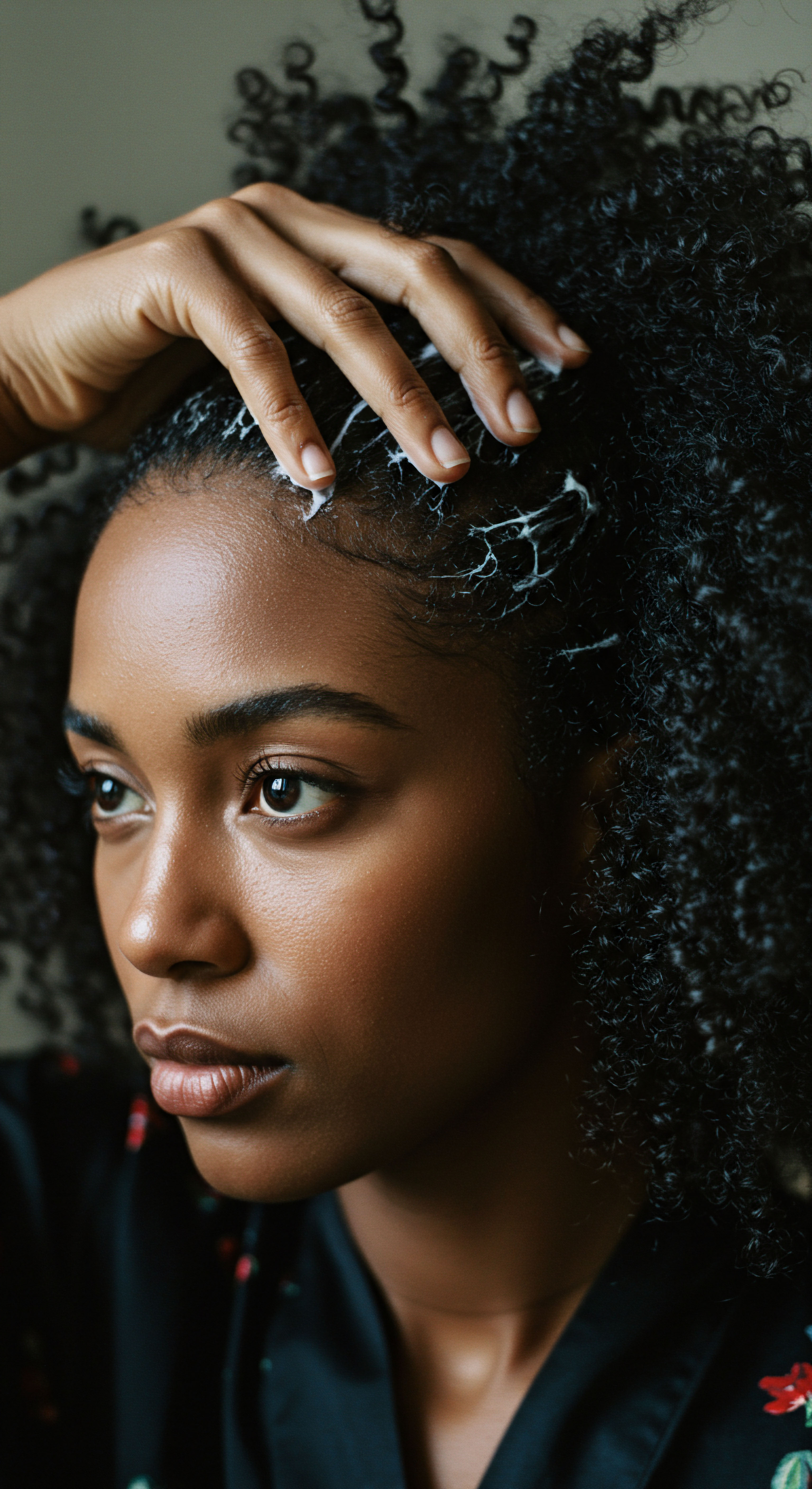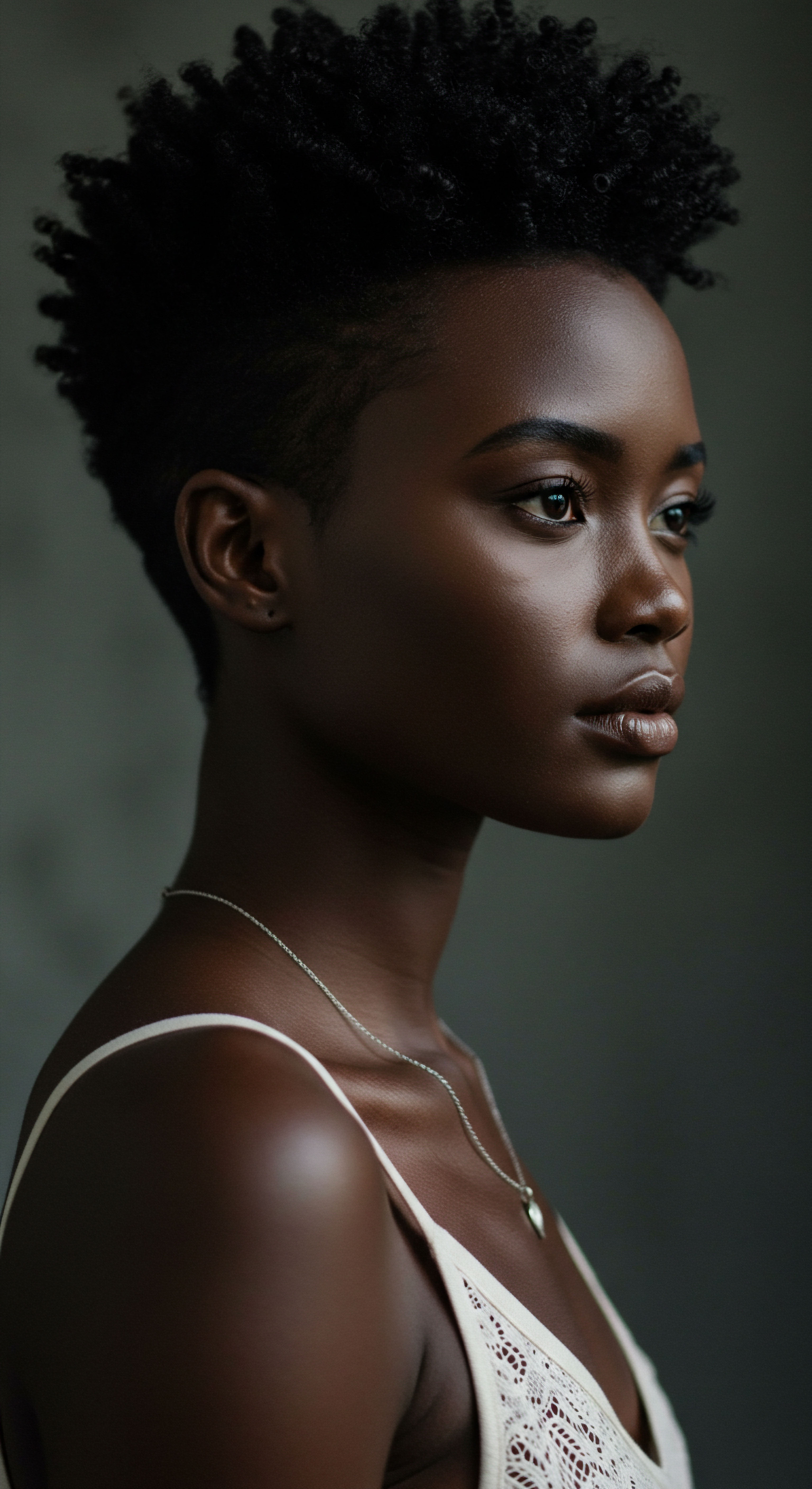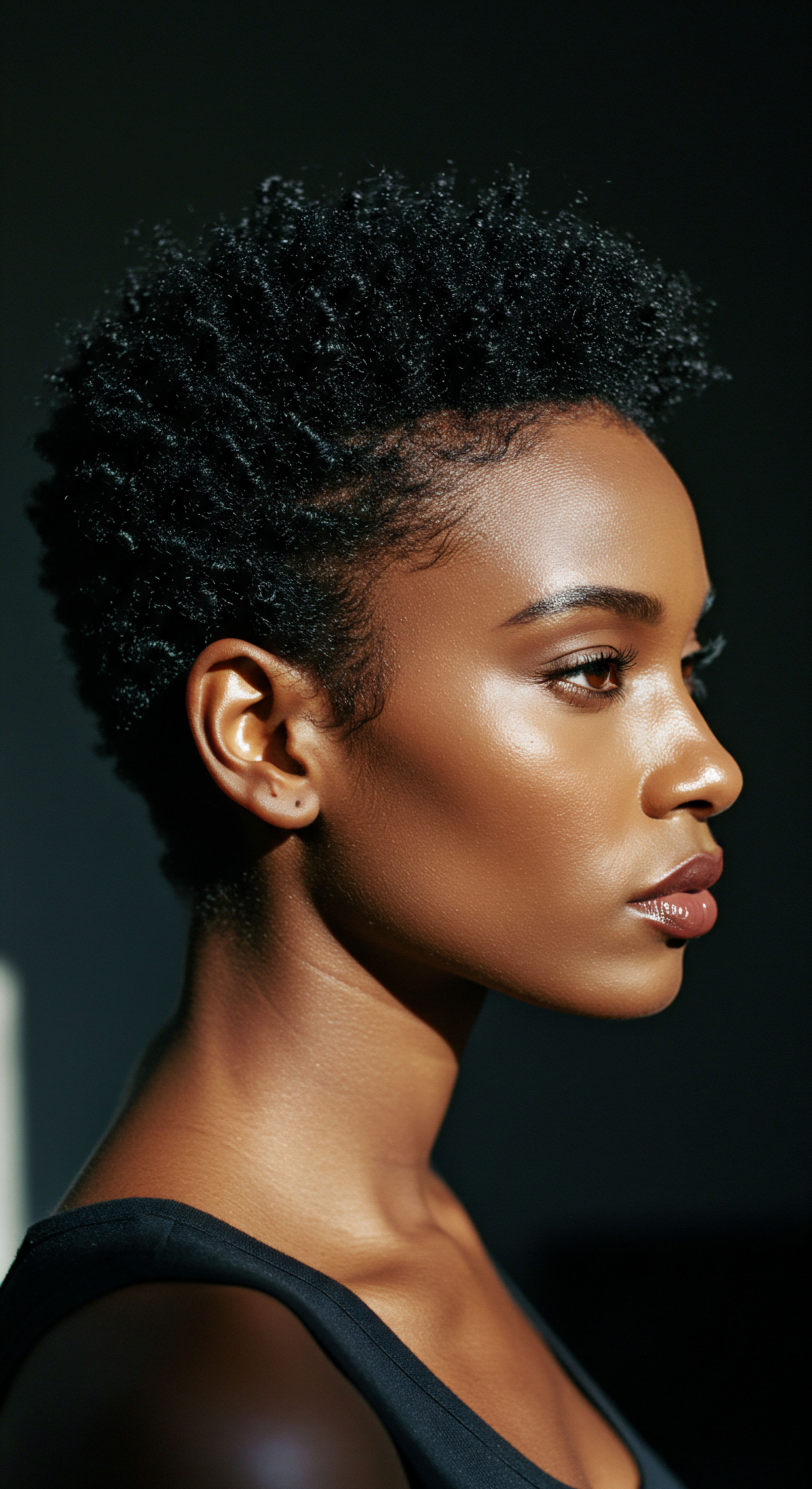
Roots
The quiet hours of the night, when the world settles into slumber, hold a subtle yet significant impact on the well-being of curly hair strands. For those with coils and waves, the evening transition from day to rest is not merely a cessation of activity, but a period demanding specific consideration to preserve the very structure and vitality of their hair. A curl, in its delicate formation, possesses an inherent vulnerability that straight strands often do not share.
Each bend and curve in a curly strand represents a point where the cuticle, the hair’s protective outer layer, lifts ever so slightly. This unique architecture, while contributing to the hair’s beautiful spring and volume, also renders it more susceptible to moisture loss and mechanical stress.
Consider the daily life of a curly strand ❉ it contends with environmental humidity, styling manipulations, and the constant pull of gravity. Then, as evening arrives, it meets the pillow, a surface that, depending on its composition, can either act as a gentle ally or an unwitting adversary. The friction generated during sleep, even from seemingly soft materials, can disrupt the already raised cuticles, leading to undesirable outcomes.
This nighttime interaction, often overlooked in the broader scope of hair care routines, holds a surprising weight in determining the hair’s condition upon waking. The fundamental need for gentle night care for curly hair is rooted in its very anatomy and the physical forces it encounters during sleep.
The delicate structure of curly hair, with its naturally raised cuticles, makes it particularly susceptible to friction and moisture loss during sleep, necessitating a specific nighttime care approach.

Understanding Hair Structure and Its Nighttime Vulnerabilities
The human hair strand, a complex biological creation, consists of three primary layers ❉ the medulla, the cortex, and the cuticle. While the medulla, the innermost core, is not present in all hair types, and the cortex forms the bulk of the hair’s strength and pigment, it is the Cuticle that bears the brunt of external interactions. This outermost layer is comprised of overlapping cells, much like shingles on a roof, that lie flat in healthy, straight hair.
For curly hair, however, these scales do not lie as smoothly. The very act of forming a curl means the cuticle scales are inherently more prone to lifting, creating a rougher surface.
When this already open cuticle surface encounters friction, such as rubbing against a pillowcase for hours, the scales can lift further, chip, or even break. This disruption leads to several undesirable outcomes:
- Increased Friction ❉ The rougher surface of the hair against itself and the pillow causes more resistance.
- Moisture Evaporation ❉ An open cuticle allows the hair’s internal hydration to escape more readily into the air.
- Protein Loss ❉ The protective keratin proteins within the hair shaft become more exposed and vulnerable.
These factors combine to create a cycle of damage that can result in frizz, tangles, dullness, and ultimately, breakage. The hours spent in sleep, seemingly passive, are in fact a period of considerable activity for the hair on a microscopic level.

How Do Environmental Factors at Night Influence Hair?
Beyond the direct contact with bedding, the ambient conditions of a sleeping environment also play a role in hair health. Humidity levels, for instance, can affect how much moisture the hair retains or loses overnight. In very dry environments, hair is more prone to dehydration, especially if its cuticle is already compromised. Conversely, excessive humidity can lead to the hair absorbing too much moisture, causing it to swell and potentially disrupt curl patterns, leading to frizz.
Furthermore, the simple act of tossing and turning, a natural part of human sleep, exacerbates the mechanical stress on hair. An average person moves their head approximately 40 times per night. Each movement, when multiplied by the rough surface of a standard cotton pillowcase, contributes to cumulative damage over time. This continuous, low-level abrasion can chip away at the hair’s protective layers, leading to long-term structural weakening.
| Material Cotton |
| Friction Level High |
| Moisture Absorption High (absorbent) |
| Hair Impact Increased frizz, tangles, dryness, breakage |
| Material Silk/Satin |
| Friction Level Low |
| Moisture Absorption Low (non-absorbent) |
| Hair Impact Reduced frizz, tangles, moisture retention, smoother strands |
| Material The choice of pillowcase material significantly influences hair health during sleep. |

Ritual
As the day’s light softens and the world prepares for its quiet pause, so too should our attention shift to the deliberate practices that safeguard our textured hair. This is where the notion of a nighttime ritual for curly strands truly comes into its own. It moves beyond a mere habit and becomes a conscious act of preservation, a gentle conversation with our curls before they settle into their nightly rest.
The practices we choose, from the tools we employ to the very fabrics we allow near our delicate coils, directly shape their resilience and vibrancy upon waking. It is a practical wisdom, refined through generations and supported by an understanding of hair’s unique needs, that guides these evening steps.
The pursuit of serene, well-defined curls in the morning often begins long before the sun rises. It begins with the thoughtful application of protective measures, transforming the sleeping space into a sanctuary for hair. This applied knowledge, bridging scientific understanding with lived experience, helps mitigate the challenges posed by friction and moisture loss, allowing curls to maintain their structure and hydration.
Transforming the sleeping environment into a sanctuary for curly hair through specific rituals helps maintain curl integrity and hydration.

Why Does Hair Need Protection From Friction at Night?
Friction, that seemingly innocuous rubbing, poses a significant threat to the delicate structure of curly hair. During sleep, as one shifts and turns, hair rubs against the pillowcase, against itself, and even against the body. This constant mechanical agitation causes the hair’s cuticle scales to lift and abrade. When these scales are roughened, the hair shaft loses its smoothness, leading to:
- Frizz ❉ The lifted cuticles cause individual strands to stand away from the main body of hair, creating a halo of frizz.
- Tangles and Knots ❉ Rough surfaces catch on each other, causing strands to intertwine and form difficult-to-remove tangles.
- Breakage and Split Ends ❉ The repeated friction weakens the hair shaft, making it brittle and prone to snapping, particularly at the ends.
A study highlighted in Vogue Scandinavia notes that cotton, when woven into fabric, roughens up, and this can cause hair to suffer from breakage, frizz, and tangling from nighttime movements. This mechanical wear and tear, accumulated over seven to eight hours of sleep, can undo the benefits of even the most meticulous daytime care.

What Are the Best Ways to Protect Hair from Nighttime Damage?
Protecting curly hair at night involves creating a barrier against friction and preserving moisture. Several methods and tools serve this purpose, each with its own benefits.

The Choice of Sleep Surface
The material of the pillowcase is a primary determinant of nighttime hair damage. Traditional cotton pillowcases are highly absorbent and have a rougher surface at a microscopic level, even those with high thread counts. This roughness creates significant friction, drawing moisture away from the hair and causing cuticle damage.
In contrast, Silk and Satin pillowcases offer a smoother surface. Silk, a protein-based fiber, has a lower coefficient of friction, allowing hair to glide over it with minimal resistance. This reduces tangles, frizz, and breakage.
Furthermore, silk is less absorbent than cotton, helping hair retain its natural oils and applied products, which is particularly beneficial for moisture-thirsty curly strands. One personal account noted a 43% reduction in hair breakage after switching from cotton to a satin cap, with significant improvement in morning frizz and moisture retention.

Protective Hairstyles for Sleep
Beyond the pillowcase, specific hairstyles can significantly reduce friction and maintain curl patterns. These styles aim to gather and secure the hair, minimizing its contact with external surfaces.
- Pineapple Technique ❉ This involves gathering all hair loosely at the very top of the head, securing it with a soft scrunchie or silk tie. This keeps the bulk of the hair elevated and off the pillow, reducing pressure and friction.
- Loose Buns or Braids ❉ For longer hair, a loose bun at the crown or nape, or a loose braid, can prevent tangling and preserve curl definition. The key is to keep these styles loose to avoid tension on the scalp and hair follicles.
- Two Strand Twists or Bantu Knots ❉ These styles, when done loosely for sleep, can not only protect the hair but also enhance curl definition for the following day.

Hair Coverings
Bonnets and scarves, especially those made of silk or satin, provide an additional layer of protection. These coverings fully enclose the hair, shielding it from friction with bedding and the surrounding air. They are particularly effective at maintaining moisture levels and preserving styled hair. The historical and cultural significance of head coverings for hair protection, particularly within African American communities, speaks to their long-standing recognition as a vital element of hair care.

Relay
The simple act of sleep, a restorative necessity for the body, carries a deeper, more complex resonance for curly hair strands. It is during these hours of repose that the subtle interplay of cellular repair, hormonal rhythms, and environmental interactions shapes the very destiny of our coils. The question of why curly hair demands such gentle nighttime attention transcends superficial concerns of frizz or definition; it delves into the intricate biological and physical vulnerabilities unique to textured hair, vulnerabilities that, left unaddressed, can compromise its long-term health and vitality. This exploration seeks to bridge the chasm between anecdotal wisdom and scientific understanding, revealing the profound interconnectedness of our sleep habits and the very resilience of our hair.
The nocturnal environment, far from being inert, becomes a silent battleground for hair integrity. Understanding the microscopic consequences of friction, the subtle drain of moisture, and the physiological processes occurring during sleep allows for a more informed, culturally intelligent approach to nighttime hair care. It is a practice steeped in both ancestral knowledge and modern scientific inquiry, offering a path to truly thriving hair.

What is the Microscopic Impact of Nighttime Friction on Hair?
At the microscopic level, the hair cuticle, composed of flattened, overlapping cells, serves as the hair’s primary defense. In curly hair, these cuticle scales are naturally less tightly aligned due to the helical shape of the strand. When hair rubs against abrasive surfaces, such as typical cotton pillowcases, the constant mechanical force causes these scales to lift, fray, and even break away.
This damage is cumulative. Each night, tiny fragments of the cuticle are lost, leading to a progressively compromised outer layer. A study published in the Journal of Cosmetic Dermatology indicated that silk’s smooth surface can reduce hair friction by up to 43% compared to other pillowcase fabrics. This reduction is critical because mechanical force is a primary cause of hair damage, encompassing even the subtle friction of hair sliding past itself or against bedding.
The compromised cuticle then leaves the hair’s inner cortex, rich in keratin proteins, exposed. This exposure makes the hair vulnerable to:
- Accelerated Dehydration ❉ The open cuticle allows moisture to escape rapidly, leaving the hair dry, brittle, and prone to further damage.
- Increased Porosity ❉ Damaged cuticles create gaps, making the hair more porous and less able to retain hydration or beneficial products.
- Protein Degradation ❉ The exposed cortex is more susceptible to the degradation of its structural proteins, weakening the strand from within.
This cascade of microscopic events ultimately manifests as visible frizz, loss of curl definition, dullness, and increased breakage. The long-term consequences of consistent cuticle damage can include chronic dryness and reduced hair strength.

How Do Sleep Cycles Influence Hair Growth and Health?
Beyond mechanical protection, sleep itself plays a vital physiological role in hair health. The body undergoes significant restorative processes during sleep, many of which directly impact hair growth and overall vitality. Scientific research has increasingly illuminated the connection between adequate sleep and hair follicle health.
During the deep non-REM and REM sleep cycles, the body’s protein synthesis is at its peak. This is when the body actively repairs, restores, and strengthens cells, including those within the hair follicles. Key hormones and enzymes crucial for hair growth are released during these periods:
- Melatonin ❉ This hormone, primarily known for regulating the sleep-wake cycle, also influences hair cycle timing. Melatonin receptors have been identified in human hair follicles, suggesting its direct role in hair growth. Poor sleep can reduce melatonin production, potentially slowing hair growth.
- Growth Hormone ❉ Released during deep sleep, this hormone triggers downstream insulin-like growth factors, which are essential for boosting keratin production, the primary protein component of hair.
- Estrogen ❉ This hormone stimulates hair follicle cell proliferation, supporting the active anagen (growth) phase of hair.
Lack of consistent, quality sleep can disrupt these hormonal balances and protein synthesis, prematurely pushing hair follicles into the telogen (resting/shedding) phase, leading to thinning and hair loss. Therefore, gentle night care for curly hair extends beyond physical protection to supporting the very biological processes that keep strands healthy and vibrant.

Cultural Significance of Nighttime Hair Protection
The practice of protecting hair at night is not a modern invention; it carries deep historical and cultural roots, particularly within communities with textured hair. For centuries, head coverings and specific nighttime routines have been integral to hair care traditions across various cultures.
In African American communities, for instance, bonnets and headwraps have a profound history. Initially, during periods of enslavement, these coverings served as a practical means to protect hair from harsh conditions and limited resources. They also became symbols of resilience and identity, with women reclaiming their dignity and even using folds in headscarves to communicate coded messages.
Post-slavery, these practices persisted, primarily to preserve hair health and styles. The smooth surfaces of silk or satin used in these coverings allowed hair to glide, preventing friction and moisture loss, thereby combating breakage and split ends.
Beyond African traditions, silk hair wraps have been used in East Asian cultures, such as by Geishas in Japan to maintain intricate hairstyles, and by noblewomen in Korea. In India, silk scarves protected hair from environmental elements and reduced friction. These historical practices underscore a long-standing, intuitive understanding of the benefits of gentle nighttime hair care, predating modern scientific explanations. They represent a collective wisdom passed down through generations, recognizing the vulnerability of hair and the importance of its preservation.
The contemporary recommendation for silk pillowcases and bonnets, therefore, aligns with a long lineage of cultural practices that instinctively understood the principles of friction reduction and moisture retention for hair health. The science now simply provides a deeper explanation for these time-honored rituals.

Reflection
The quiet hours of slumber, often perceived as a mere pause, are in fact a dynamic canvas upon which the health and vitality of our curly strands are subtly painted. To consider gentle night care for textured hair as a superficial concern would be to overlook a profound dialogue between our biological rhythms, environmental interactions, and centuries of ancestral wisdom. It is a testament to the delicate yet resilient nature of coils and waves, reminding us that true well-being for our hair extends far beyond the daytime routine, finding its deepest nourishment and protection in the tender embrace of the night.

References
- 1. Van Lerberghe, L. & Baeck, M. (2014). A case of acute contact dermatitis induced by formaldehyde in hair-straightening products. Contact Dermatitis, 70(6), 384–386.
- 2. Gavazzoni, R. (2014). Hair Cosmetics ❉ An Overview. International Journal of Trichology, 6(3), 101–104.
- 3. Draelos, Z. D. (2011). Hair Cosmetics. Dermatologic Clinics, 29(1), 167–173.
- 4. Trueb, R. M. (2001). The value of hair cosmetics and pharmaceuticals. Dermatology, 202(4), 275–282.
- 5. Robbins, C. R. (2012). Chemical and Physical Behavior of Human Hair (5th ed.). Springer.
- 6. Wilkes, R. (2018). The Science of Hair Care. CRC Press.
- 7. Sperling, L. C. (2012). An Atlas of Hair Pathology with Clinical Correlations. Informa Healthcare.
- 8. American Academy of Dermatology Association. (n.d.). Hair Loss ❉ Common Causes. Retrieved from aad.org.
- 9. Rele, A. & Mohile, R. B. (2014). Effect of Friction on Hair. International Journal of Trichology, 6(3), 105–108.
- 10. Kumar, A. & Sharma, M. (2015). A Review on Hair Structure, Growth and its Disorders. Journal of Pharmacognosy and Phytochemistry, 4(1), 22-26.